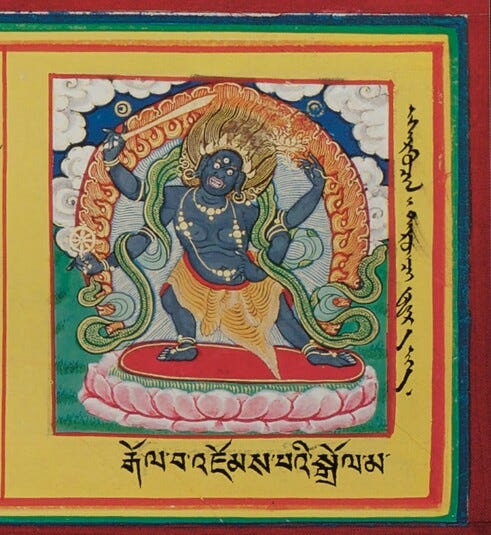The Hidden Yogic Meaning Behind the Praises of Tārā in Twenty-one Verses Revealing Prāṇāyāma Yogāṅga #verse7

Sanskrit verse 7
namastraḍitiphaṭkāraparayantrapramardani |
pratyālīḍhapadanyāse śikhijvālākulekṣaṇe ||
Tibetan verse 7
ཕྱག་འཚལ་ཏྲཊ་ཅེས་བྱ་དང་ཕཊ་ཀྱིས། །ཕ་རོལ་འཁྲུལ་འཁོར་རབ་ཏུ་འཇོམས་མ། །གཡས་བསྐུམས་གཡོན་བརྐྱངས་ཞབས་ཀྱིས་མནན་ཏེ། །མེ་འབར་འཁྲུག་པ་ཤིན་ཏུ་འབར་མ།
English translation [of the Tibetan verse]
Homage to you [Tārā], who with traṭ and phaṭ, Crush the enemies’ yantras to dust. With right leg bent in and left leg extended, Shining you tread amidst flames wildly blazing.
The hidden meaning behind this verse [showing the practice of prāṇāyāma], as explained by Tārānātha
namaḥ traditi phaṭkāra parayantra pramardini|
pratyālīḍha padanyāse śikhī jvālā kulojjvale||
The [Sanskrit] word trata/trada [ཏྲཊ་] means to break or tear, and the word phat [ཕཊ་] means the end or destruction of conceptual thoughts. It ends [Mardini] the yantra of karma and kleśa that is, the air of twelve lagana [zodiac].
The right leg bent and the left leg extended [Pratyālīḍha] denotes that the right channel is retracted, its mouth facing upward, and the left channel is extended, its mouth facing downward.
Her feet trample/tread [padanyāse] means the feet [or bottom] of the central channel trample on the right and left channels [below the navel], thereby stopping the air flowing through the right and left channels in the central channel.
The blazing fire [jvālā] means [by stopping the air of the sun, the right channel, and the moon, the left channel, in the central channel] the fire of tummo [caṇḍālī] blazes. As the fire of tummo melts the bindu [in the crown], the water [bindu] is stirred [འཁྲུག་པ], making the fire of tummo blaze more fiercely [ujjvala].
This [verse] reveals the prāṇāyāma yogāṅga.
Note:
I found the Sanskrit text in the Digital Sanskrit Buddhist Canon - Books (dsbcproject.org) tārānamaskāraikaviṃśatistotram
English translation of Tibetan verse is from Lotsawa website: Translated by Samye Translations (trans. Stefan Mang, Peter Woods, and Ryan Conlon, ed. Libby Hogg) with the kind assistance of Adam Pearcey, 2019.
Taranatha's explanation is taken from his text ‘Commentary on the praises to Tārā. He says this verse reveals the Prāṇāyāma Yogāṅga


